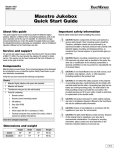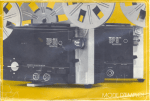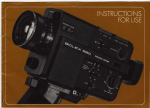Download Bolex SM8 Sound Projector
Transcript
\' fr • Souno'Pfojector Instructio n manu,al , . Our international organization offers impeccable after-sales service throughout the world. You can entrust your Bolex equipment to a Paillard-Bolex distributor with complete confidence. He employs qualified technicians, usually trained in the Paillard factories in Switzerland. Get to know your projector Making the sound track Main features 17 A guide to recording Preliminary 18 Preparing to record background sound 19 Recording background 20 Recording speech steps music 8 Voltage selection and fuse 8 First lubrication 21 Checking results during recording 9 Power supply and intermission light 21 Sound superimposition 22 Sound mixing 23 Correcting 23 Erasing Setting up the projector 10 Positioning the projector - Distance chart 11 Preparing for projection 13 Automatic threading Projection 14 Projecting silent films 15 Projecting sound films 16 Removing partially projected film (overplay) a recorded passage (retake) Maintenance 24 Lubrication 24 Replacing and centering projection 25 Cleaning the gate 25 Sound head lamp Equipment 16 Reverse motion 26 Supplied with the projector 16 Rewinding 26 Supplied as accessories 3 1 2 Feed spool Folding arm (page 12) 3 4 5 Loop former and threading switch (page 13) Upper sprocket (page 13) Upper sprocket shoe (page 16) 6 7 Lens holder (page 16) Film disengaging lever (page 16) 8 Framing control (page 14) 9 10 11 Control switch (page 14) Magnetic sound heads (page 25) Recording telltale lamp (page 17) 12 13 14 V. U. meter (page 18) Operating telltale lamp (pages 9 and 17) Recording switches (page 17) 15 16 17 Playback switch (page 17) Tone control (pages 15 and 18) Counter zero setting 18 19 20 21 22 23 24 Volume control (pages 15 and 18) Input for microphone or record player (page 18) Projection speed selector (projector running) Lower sprocket shoe (pages 12 and 16) Take-up spool Film guide (page 12) Lower sprocket 25 26 Retracting handle (page 7) Lamp-house (page 24) 4 22 23 24 25 26 2 3 4 5 6 7 8 21 9 10 27 27 Ventilation 28 Switch for built-in speaker (page 15) 29 Fluted knob for projector levelling 30 Connection loudspeaker 31 Mains connection (page 9) 32 Socket for intermission light (page 9) 33 Built-in loudspeaker 34 Fluted knob adjustment \ \I 28 34 6 33 32 31 30 I 29 exhaust for for loud- external height Sound projector separation 18 ± Standard Super 8 sound-picture Dimensions: Weight: Conversion from one mains frequency to another can be for Super 8 film 1/2 frames 14" x 10" x 7" distributor. To release the retracting handle, press down and push it 25 Ibs. (including lens) towards 100 % automatic threading with BOLEX 400 ft. spool Capacity: effected by a Paillard-Bolex the back of the projector. To replace, fully depress the handle and push forward. spools up to 800 ft. Silent or sound projection in forward and reverse motion. Speeds: 18 and 24 f. p. s. 12 V/100 W iodine-quartz lamp Lamp warming-up at approximately 40 % of its full power Separate motor for cooling Socket for intermission Counter: light 1 unit = about 25 frames Transistorized amplifier, 4W power output with 5% harmonic distortion Built-in 2 W/5 +5 ohms loudspeaker Connection for external 6 W/5 + 5 ohms loudspeaker Tone control during playback Recording and playback operated by keyboard switches or microphone Superimposition operated by remote control from the microphone Sound level control with luminous V. U. meter 7 By reading the instructions and suggestions in this manual, you will rapidly master the art of using your BOLEX. SM8 projector and be able to take full advantage of its outstanding versatil ity. 1. Voltage selection The voltage selector is located under the projector. Before connecting the mains lead, make sure that the selector is set opposite the local mains voltage. If not, unscrew the milled knob a, change the fuse if necessary and screw the knob right home, setting the selector to the correct voltage. Fuse necessary for 110-160 V: 1,6 A 220-240 V: 0,8 A 2. First lubrication Before using the projector for the first time, it is advisable to lightly lubricate the felt of the cams and bearings which support the main driving shaft. b 8 c Disconnect the mains lead and open the back cover by loosening locking screws band c. Place one or two drops of very fine oil on the five points marked in red and indicated opposite. 3. Power supply and intermission light Connect the projector to the mains by plugging the mains lead into socket 31. The green telltale lamp 13 goes on and the fan starts up. A table lamp can be connected to the projector by plugging the cable into socket 32. The lamp automatically goes out when the projection lamp is switched on at full power and lights up again when the projection lamp goes off. (Table lamp must not exceed 100 watts). 8 c(j 6w5+5 f\. 9 1. Positioning the projector Place the projector distance. opposite the screen at the desired For small-group viewings, where all the spectators are gathered around the projector, we would not recommend using a screen larger than 5'6" x 4'2". Approximate picture sizes at varying distances: Distances I 10 \ 8 10 15 20 25 30 40 50 ft. ft. ft. ft. ft. ft. Lenses I 15 mm. 34 42 64 85 107 128 x 25" X 32" x 48" x 64" x 80" X 96" ft. - ft. - I 20 mm. 25 32 48 64 80 96 128 x 19" x 24" x 36" X 48" X 60" x 72" X 96" - 25 mm. 20 25 38 51 64 77 102 128 x x x x 15" 19" 29" 38" X 48" x'58" x 77" X 96" I 35 mm. 18 27 36 45 55 73 91 x x x x x x x 13" 20" 27" 34" 41" 55" 69" I 2. Preparing for projection • Start the projector by moving the control switch 9 to position M (forward motion, lamp warming up). . • Select the projection speed with the projector running. • Adjust the focus by rotating the lens mount. If the projector is equipped with a zoom lens, set the focal length by rotating lens ring d and adjust the focus by moving the mount e. • Adjust picture height and projector • Stop the projector. level with fluted knobs f and g respectively. d e 11 • Raise the spool holder arm 2 to its operating position and place the loaded feed spool on its spindle. In forward motion, the loaded spool unwinds clockwise. The film perforations should be towards you. • Fit on the empty BOLEX 400 ft. spool whjch will automatically engage the film. The projector accepts other spools with a capacity up to 800 ft. but, in this case, the film must be inserted manually into the slot of the take-up spool. Check that the lower sprocket shoe i is in the locked position and that the film guide h is turned towards the take-up spool. • When using an 800 ft. spool, the film guide must first be folded (diagram opposite). 12 downwards 3. Automatic threading If the end of the film is bent, straighten it. If it is damaged, make a clean cut between two perforations with scissors. To ensure correct automatic insertion into the 400 ft. spool, check that the leading end of the film is suitably curved. If it is nearly right-angled (in the case of spools holding over 400 ft.), press it slightly between the fingers to make a gentler curve. On 50 ft. spools, straighten the film leader. • Insert the leading end of the film into the slot in the upper sprocket shoe. • Press the switch of the upper loop former: this starts the mechanism and the film is automatically fed through the gate and the sound head. • Once the film has passed through the gate, the control switch can be turned to position L (lamp on) if a BOLEX take-up spool is being used. The film will automatically attach itself to the spool and projection can start. With spools requiring manual film insertion, allow approximately 1 ft. of film to project beyond the lower sprocket before releasing the upper loop former switch. Then insert the end of the film into the slot on the empty spool and turn the spool so as to slightly tighten the film. 13 1. Projecting silent films The control switch has the following five positions: To project silent films, pull the control switch outwards and move it to position M or L. This releases the pressure on the magnetic sound heads which could otherwise cause unnecessary wear. 1 2 4 1 2 3 4 5 STOP position Forward motion, Forward motion, Reverse motion, Reverse motion, 5 lamp lamp lamp lamp switched on at reduced power on switched on at reduced power on In reverse motion and at STOP (positions 1,4 and 5), the sound unit does not operate. Projection can now begin. Once the projection is begun, turn the lens mount until the picture is in sharp focus. Framing is adjusted by moving the small lever j very slowly. 14 Note: You can enhance the interest of a silent film with a musical background, by using a record-player or tape recorder during projection (see page 18). If the film calls for a commentary, you can use the microphone for public address by means of the mixing console (see page 22). 2. Projecting sound films Sound is reproduced by means of the built-in loudspeaker (position a::] of the switch 28) or the external loudspeaker, fitted into the case. If using the latter, unwind the connecting cable and plug it into the socket 30. Placed near the screen, this loudspeaker provides higher sound quality and power; it works in both positions of the switch. If the switch is turned to a::] position and the external loudspeaker is not connected, the sound is cut off. 15 3. Removing partially projected film If it is desired to remove a film before it has completely run through: • First open the gate by swinging out the lens holder. • Release the lower sprocket (diagram opposite) by pushing the shoe downwards. • Disengage the film firstly from this sprocket, then from the sound unit and the gate by pressing forwards the small lever k and lastly from the upper sprocket by pressing its lower shoe (I, diagram below). _--.J-'1:::::::-""'S-k 4. Reverse motion In reverse running, projection is of course silent. Pressure is withdrawn from the magnetic sound heads, thus avoiding unnecessary wear as well as accidental erasure. 5. Rewinding Attach the film to the core of the empty spool and move the control switch to R to set the projector running in reverse. 16 Musical fidelity depends on the quality of the magnetic sound stripe applied to the film. We therefore strongly recommend laminated or cemented tracks. An unevenly distributed magnetic coating can shorten the life of the magnetic 'sound heads. Once your film has been edited and the magnetic track applied by a specialist laboratory, you have the material for a masterpiece of your own making. You can add whatever sound effects you please. The BOLEX SM8 projector provides unlimited scope for your imagination and ingenuity while its ease of operation will delight you. 1. A guide to recording When the green telltale lamp is alight, this indicates that the projector is connected to the mains and that the sound head is in playback position. The recording relay is engaged when the record player plug is introduced into the socket 19 of the projector. On pressing the two red keyboard switches simultaneously, the red telltale lamp comes on and the projector is ready to record. To return to playback position, presse the centre green switch: the relay is disengaged and the red telltale lamp goes off. When using the microphone, continuous pressure on the microphone switches governs recording and superimposition by remote control. Note: To safeguard against accidental erasure, the recording relay does not engage unless a plug has been introduced into the projector socket 19. If, by mistake, the two red switches are pressed simultaneously, the recorded sound will be diminished during this time, when the projector is running. 17 • Recording involves the total erasure of a previous recording, except in the case of superimposition (see page 21). speech and music from two different sources by using the three-channel mixing console, supplied as an accessory (see page 22). • As soon as the red telltale lamp goes on - in other words, at the beginning of recording - the built-in or external loudspeaker operates at very low strength, making it possible to monitor the passage being recorded and follow the course of the recording very easily. 2. Preparing to record background sound • The sound level can be .checked in the V. U. meter when the red telltale lamp is alight. • The tone control knob @ does not operate during recording. In order to concentrate the operator's attention on sound and picture synchronization, only one socket is provided for the record-player or microphone input. Thus the musical background is recorded first and speech is superimposed during a second passage of the film. It is however possible to simultaneously record 18 • Plug the record player lead into the socket 19 and connect it or the tape recorder to the mains. • Listen to the record or the tape, using the built-in or external loudspeaker. • With the projector stopped, simultaneously press the two red recording switches and adjust the recording level with knob watching the movement of the V. U. meter needle which should not leave the black segment a, on the dial. The needle in the red segment indicates track, resulting in distortion during playback. saturation of the magnetic • Replace the sound head in playback position by pressing the green keyboard switch. 3. Recording background music • Load the projector and select the desired speed with the projector running. • Using the control switch, place the first frame of the film (or of the sequence to be recorded) opposite the film gate aperture. • Turn the counter to zero by moving the milled disc downwards. • Run the projector in reverse for a few moments until the numbers 997 (or lower, if you have a sufficently long lead-in tape), appear in the counter. This enables the motor to attain its normal speed and thus prevents any risk of wow and flutter at playback. • Move the control switch to M (lamp switched on at reduced power). The projector is running and you can follow projection during the recording. • Watch the counter. When it indicates zero (or when the first frame of the sequence to be recorded is projected), quickly press the two red recording switches and engage the tape recorder or record player, one or the other having already been prepared to play the chosen music. During knob recording, C). correct the sound level if necessary with the volume control • Press the green playback key at the end of recording. The same procedure can be followed when recording sound effects from a record or a tape. After recording a short section, it is as well to check the results (page 21). 19 4. Recording speech Insert the microphone plug into the socket 19. The microphone has two switches and two functions: • Recording (with complete erasure of a previous recording), operated by simultaneously pressing the red and black switches. • Superimposition (see following page), operated by press·ing red switch alone. In both cases, this remote control replaces the use of the projector keyboard switches. As soon as the microphone switches are released, the red telltale lamp goes out and the sound head returns to playback position. • By way of a triai run, without starting the projector, press the two microphone switches and speak at a normal level. Adjust the volume with knob and observe the level indicator. In the loudest passages, the indicator needle should not appreciably exceed the black segment on the dial or distortion will result during playback. • Position the film and return the counter to zero (see preceding page). • Run the projector in reverse for a few moments until the figures 997 (or lower), appear in the counter. • Move the control switch to M: the projector is running. • Watch the counter. When it indicates zero (or when the first frame of the sequence to be recorded is projected) press the red and black microphone switches and start speaking. During recording, with knob correct the sound level if necessary (3 • At the end of the commentary, release the two microphone switches. (3 20 Note: It is advisable to hold the microphone as far away as possible from the projector to avoid picking up mechanical noise. 5. Checking results during recording • Run the projector cates 997 (or less). in reverse until the counter indi- • Make sure you have not forgotten to disengage the recording relay. The red lamp should be out. If this has not been done, press the green keyboard switch. 2 1 3 • Play back the recorded section and, if satisfactory, continue with the rest of the recording. Note: It is unnecessary to re-set the counter at zero every time you interrupt recording. Simply run the projector in reverse for three units before resuming recording. A superimposition • First above. • 6. Sound superimposition (overplay) The red switch on the microphone is used to superimpose a commentary, sound effects and possibly music onto a previous recording (1) which is then automatically reduced to approximately 50 %. At the second superimposed recording (2), the commentary will be clearly audible above the background music (3). record is achieved as follows: the background Plug the microphone as described into the projector • Adjust the volume with knob meter. • sound 6, observing socket 19. the V. U. Move the control switch to M; the projector is running. • When reaching the passage to be superimposed (use as a guide either the picture or the previously recorded sound, audible over the loudspeaker), press the red microphone switch and start speaking. Release the switch at the end of the commentary. 21 7. Sound mixing Speech, music and sound effects can be recorded simultaneously by using the mixing console, which is available as an accessory. This has three channels with individual controls. • Plug the mixing unit into the projector socket 19. • Plug the microphone into socket m and the recordplayer(s) or tape recorder into the sockets n. • Following the procedures explained above, make a trial mixing run without starting the projector. With the mixing console, the microphone remote control does not operate and the projector keyboard is used. The volume control knob of the projector should be set at maxrrnurn. 6 The MICRO knob of the mixing console adjusts the amplification of sound picked up by the microphone. Knobs PHONO 1 and PHONO 2 allow for music or sound effects to be adjusted to the desired level (checking with the V. U. meter). Before recording, it is advisable to have a run through and adjust the levels of speech, music and sound effects, according to the desired result. When you have determined the best positions for all three knobs, proceed to record. 22 8. Correcting a recorded passage (retake) Note: If only the commentary needs correction, the background sound cannot be retained. A completely new recording must be made by using the microphone, pressing the two switches simultaneously. Certain passages may turn out unsatisfactorily and need to be recorded afresh. This can be done with or without the mixing console, as follows: • Either visually or acoustically, the faulty passage. mark the beginning of • Set the counter to zero or note the number already indicated, • According to the correction required (music, speech or mixing), plug the microphone, record player or tape recorder in their corresponding sockets, • Without starting the projector, make a trial correction and adjust the volume of each input. 9. Erasing The magnetic track of the film passes over the erase head before reaching the recording heads. A previous recording is therefore erased. To erase the magnetic track without making a new recording: • Run the projector in reverse until the counter indicates three units less than the figure noted above. • Plug into socket 19 the record player cable without connecting it. • • Set the volume control knob • Press the two red recording switches simultaneously. • Run the film at 18 f. p. s. with the control switch on M. Re-record following the preceding instructions. At the end of the corrected passage, immediately press the green keyboard switch to avoid erasing any of the rest of the original recording. (5 at minimum. 23 1. Lubrication We recommend regular lubrication: one or two drops of fine oil should be applied to the lubrication points shown on page 9 after every 20 hours of actual operation. 2. Replacing and centering the projection lamp Remove the lamp-house cover by loosening the screw p. Pull the defective lamp up and out of its holder. When inserting the new lamp (12 V/100 W), avoid touching it with the fingers which damages the quartz. If this happens accidentally, clean the lamp at once with cotton wool dipped in alcohol. The lamp screen is centering while the 24 is correctly centred when the brightness on the uniform. It is perfectly safe to adjust lateral (with screw r) and vertical centering (screw s) lamp is on. 3. Cleaning the gate Before each projection, swing out the lens holder and clean the film gate as well as the edges of the aperture, using a clean cloth or a brush. 4. Sound head The sound head can be opened by loosening screw t and pulling the cover forward. From time to time, use a slim plastic rod and a clean cloth dipped in alcohol to clean those parts which come into contact with the film: magnetic sound heads v, their pressure-pad w, film guide x, capstan y and roller z. Important! No iron or steel object brought near the magnetic heads. To replace worn magnetic Paillard-Bolex distributor. should ever be sound heads, consult your 25 1. Supplied with the projector • Microphone • • Mains lead 6" coaxial lead for connecting • Another identical lead but equipped with a 5-pin plug (DIN 41 524)* • Lead for connecting • 1 Bolex 400 ft. spool record player intermission lamp* • 1 12 V/100 W iodine-quartz • These two cables are not supplied in the USA, since useless there. lamp 2. Supplied as accessories • A carrying case (right) with .external loudspeaker designed to provide maximum protection and ease of transport for your projector and all its equipment. A 6 W/5 + 5 ohms loudspeaker, adapted to the projector amplifier, is fitted into the case and provides top quality musical reproduction. • A protective cower (left) with a pocket, for carrying various accessories. 26 • Mixing console with three channels. The advantages of this accessory have been described on page 22, It also enables the microphone to be used for public address. • Splicer for Super 8 (and Standard 8 mm.). This splicer makes bevelled joins which pass particularly smoothly through the projection gate and, compared to conventional overlapping joins, are practically inaudible on the sound track. • Fixed focal length lenses. The standard lens supplied with the projector is the Paillard-Bolex 1: 1.3 zoom lens with a focal length variable from 14 to 25 mm. However, three other Paillard-Bolex fixed focal length lenses may be used with the projector: 15 mm, 20 mm, or 25 mm. All these lenses have a remarkable f/1.3 aperture, and an excellent correction of optical aberrations. - ~-= I III -~_ __ ,1 1\~~I"""""""~'=""- .~ 1: 1,3 f= =;- ~ -.- =~- 1=0::- = 14·25 mm , ..- j ~,.. ".' " J,§ .1:1,3f=15mm 1)7 The latest in a long line of BOLEX projectors, the SM8 sound projector is designed especially for the Super 8 format. It offers beginner and expert alike the same ease in producing that essential ingredient for exciting, memorable movies - sound. We are sure you will take full advantage of the great versatility of your BOLEX SM8 sound projector and we wish you many pleasurable hours spent in its company. With its logical and elegant design, the BOLEX Super 8 camera has initiated a new style of filming: always at the ready, this camera will allow you to catch the most unexpected scenes. With this complete liberty of action and the elimination of technical complications, you will not miss anything. PAILLARD S. A. SAINTE-CROIX (Switzerland)










































